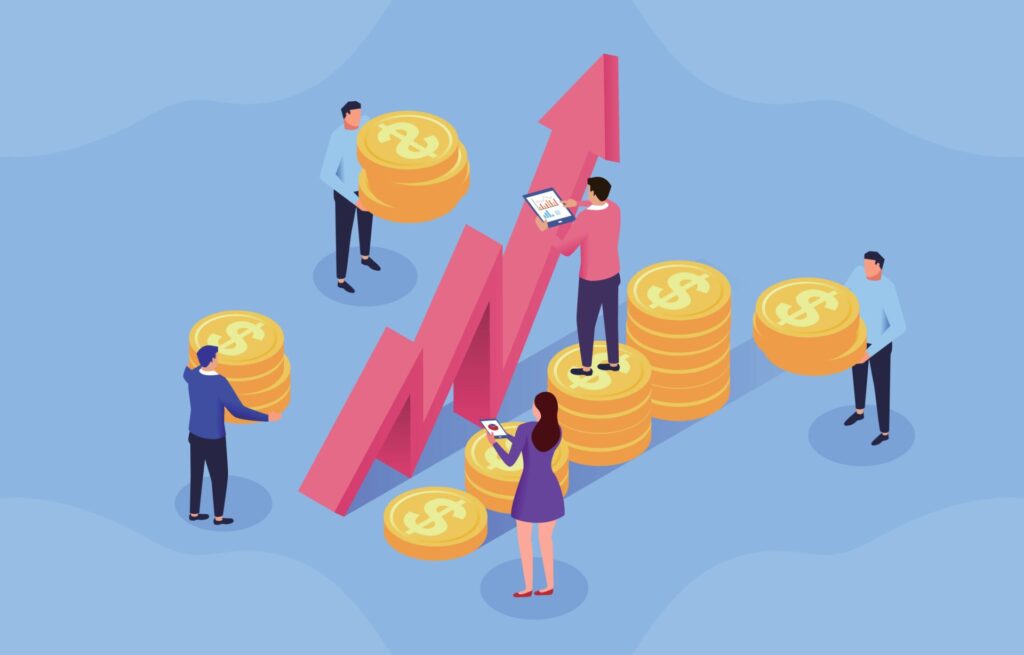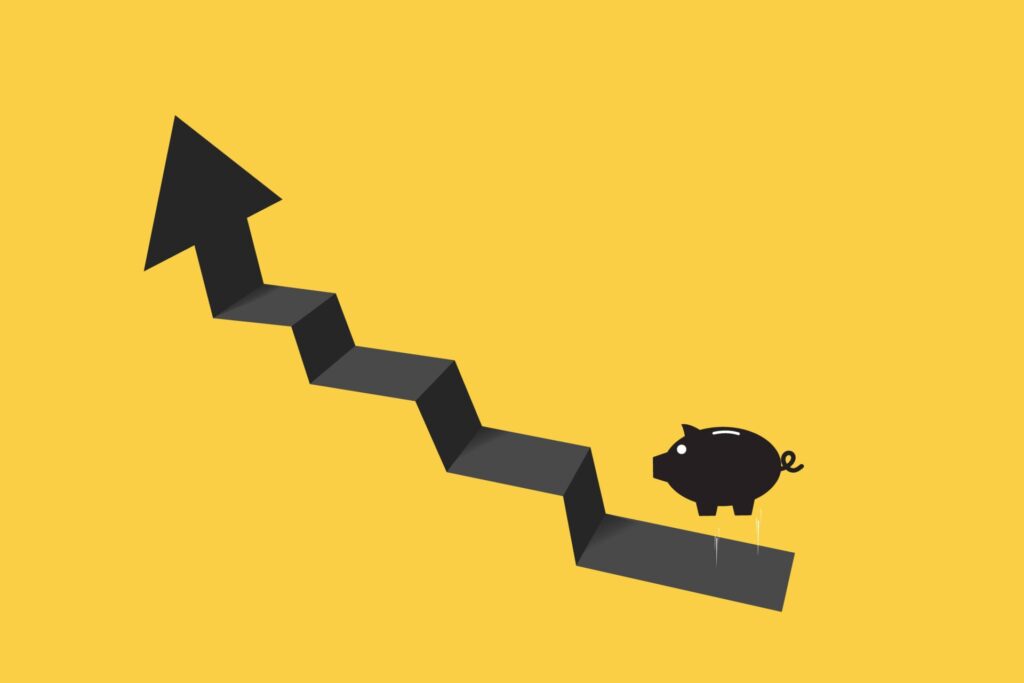Inflation and Your Finances: Why Protection is Key
Anecdote about Rising Cost of Everyday Items
Ah, the good old days. When a cup of coffee cost just a few cents and a candy bar set you back a mere dime. Fast forward to today, and you’re likely to spend more on your morning coffee than your grandparents spent on a week’s worth of groceries. It’s hard not to notice how prices have risen over the years, and it’s all thanks to inflation.
Introduce Inflation and Its Effects on Personal Finances
In this article, we’ll dive into the world of inflation, examining its effects on personal finances, and offering strategies to protect your hard-earned money.
Understanding Inflation

Definition and Basic Concept
Inflation, in simple terms, is the rate at which the general level of prices for goods and services is rising, and subsequently, purchasing power is falling. It’s like a slow and steady thief, nibbling away at the value of your money over time. Central banks often try to maintain a stable, low level of inflation, as it can have both positive and negative effects on the economy.
Causes of Inflation
Inflation can be caused by several factors, and often it’s the result of a complex interplay between these factors. Some common causes include:
- Increased demand: When demand for goods and services increases faster than the supply, prices will rise as consumers compete for limited resources.
- Higher production costs: An increase in the cost of production, such as labor or raw materials, can lead to higher prices for consumers. Businesses often pass these increased costs on to the customer.
- Monetary factors: Expansionary monetary policies, like printing more money, can lead to inflation as more money chases a fixed amount of goods and services.
Types of Inflation (Demand-Pull, Cost-Push, Built-In)
There are three main types of inflation:
- Demand-pull inflation occurs when demand for goods and services outpaces supply. This type of inflation is often associated with periods of economic growth, as consumers have more money to spend and businesses can’t keep up with the increased demand.
- Cost-push inflation is driven by increased production costs, which lead to higher prices for consumers. This can be caused by factors such as rising wages, higher raw material prices, or even supply chain disruptions.
- Built-in inflation is fueled by the expectation of rising prices, causing a self-fulfilling prophecy. When businesses and consumers expect prices to rise, they may adjust their behavior accordingly. For example, companies may increase wages in anticipation of higher costs, which in turn leads to even higher prices.
Relationship with the Economy
Inflation has a complicated relationship with the economy. Moderate inflation is generally considered a sign of a healthy economy, as it encourages spending and investing. When people expect prices to rise in the future, they’re more likely to spend their money now, boosting economic activity.
However, if inflation rates become too high or too volatile, it can wreak havoc on personal finances and the overall economy. High inflation erodes purchasing power, as the same amount of money buys fewer goods and services over time. This can lead to a decline in living standards and create uncertainty for both consumers and businesses.
Additionally, high inflation can hurt savers and investors, as the real return on their investments may be diminished. On the other hand, borrowers may benefit from high inflation if their debt is fixed, as the real value of their debt decreases over time.
In extreme cases, hyperinflation can cause an economy to collapse, as money becomes nearly worthless and people lose confidence in the currency. This is why central banks, like the Federal Reserve in the United States, carefully monitor and manage inflation rates to maintain stability in the economy.
Measuring Inflation
Consumer Price Index (CPI)
The Consumer Price Index (CPI) is the most widely recognized measure of inflation. It’s like a snapshot of the price change for a basket of goods and services that an average household typically buys. From grocery items to transportation and medical care, the CPI gives us a glimpse of how prices are changing over time.
Producer Price Index (PPI)
Another important measure of inflation is the Producer Price Index (PPI). While the CPI focuses on the consumer’s perspective, the PPI looks at the cost of goods and services from the viewpoint of producers. It’s a valuable tool to understand how changes in production costs may eventually trickle down to consumers.
Importance of Tracking Inflation Trends
Keeping an eye on inflation trends is like being the captain of your financial ship. By understanding the currents that affect the value of your money, you can navigate more effectively towards your financial goals. It also helps you make better-informed decisions about your savings, investments, and expenses.
Limitations of Inflation Measurements
Despite their usefulness, both CPI and PPI have their limitations. For instance, the CPI may not accurately reflect individual spending habits or regional differences in cost of living. Additionally, the PPI may not always capture changes in the prices of services. As a result, these indices may not perfectly represent inflation’s impact on every person or business.
How Inflation Affects Your Finances

Impact on Purchasing Power
Inflation is like an invisible tax on your money. As prices rise, the purchasing power of your hard-earned cash dwindles. It’s like running a race where the finish line keeps moving further away. Remember how your grandparents used to tell you about the days when a movie ticket cost a quarter? That’s inflation at work.
Effect on Savings and Investments
Inflation can also impact your savings and investments. For instance, if the interest rate on your savings account is lower than the rate of inflation, the real value of your savings is actually decreasing. It’s like trying to fill a leaky bucket. On the investment side, inflation can erode the real returns of bonds, stocks, and other assets.
Comparisons between Periods of High and Low Inflation
In times of low inflation, people’s purchasing power remains relatively stable, and investment returns can be more predictable. However, during periods of high inflation, uncertainty increases, and the purchasing power of money declines rapidly. It’s like going from a leisurely stroll to navigating a financial roller coaster.
Personal Experience of Dealing with Inflation
As a financial blogger, I’ve seen the effects of inflation firsthand. I’ve had to adjust my budget and investment strategy to adapt to rising prices and changing economic conditions. By understanding inflation and how it impacts my finances, I’ve been able to stay afloat in the ever-changing sea of the economy.
How Inflation Affects the Job Market
The Wage-Price Spiral
Inflation can create a vicious cycle in the job market known as the wage-price spiral. As prices rise due to inflation, workers demand higher wages to maintain their purchasing power. In turn, higher wages increase the production costs for businesses, leading them to raise prices further, and the cycle continues. The wage-price spiral can result in a significant rise in the cost of living, reducing the real value of workers’ earnings.
Effect on Employment and Job Opportunities
Inflation can also have a significant impact on employment and job opportunities. As businesses face higher production costs, they may reduce hiring or lay off workers to control expenses. Moreover, in high-inflation environments, workers may need to change jobs frequently to keep up with rising wages, creating instability in the job market. Inflation can also affect the types of jobs available, with sectors like healthcare, education, and public services potentially experiencing higher demand, while other sectors may face reduced demand.
Strategies for Navigating the Job Market during Inflationary Periods
Navigating the job market during inflationary periods requires resilience and adaptability. Some strategies to consider include developing in-demand skills that can command higher wages, seeking employment in sectors with stronger job prospects, and considering freelance or contract work to take advantage of higher wages. Networking and building relationships with industry professionals can also help you stay informed about job opportunities and industry trends. Finally, maintaining a flexible and open-minded approach to career development can help you stay ahead of the curve during inflationary periods.
Strategies to Protect Your Finances

Diversifying Investments: The Investment Smorgasbord
Diversification is the financial equivalent of not putting all your eggs in one basket. By spreading your investments across various asset classes, you reduce the risk of suffering significant losses due to fluctuations in a single market. Diversification is essential in protecting your finances against inflation and other market risks.
Different Asset Classes to Consider: The Financial Ingredients
There are several asset classes that you can invest in to create a well-rounded portfolio. These include:
- Stocks: Owning shares in companies can provide capital appreciation and dividend income. Stocks generally outpace inflation over time, making them a vital ingredient in your investment recipe.
- Bonds: Bonds are debt instruments issued by governments or corporations. They pay regular interest and can provide stability in a diversified portfolio. While bonds may not always outperform inflation, they can help balance the risk associated with stocks.
- Commodities: Investing in commodities like gold, silver, and oil can offer a hedge against inflation. As the prices of these assets often rise with inflation, they can act as a counterweight to other investments that might struggle during inflationary periods.
Balancing Risk and Reward: The Financial Tightrope
A well-diversified portfolio should strike a balance between risk and reward. High-risk investments, such as stocks, can offer greater potential returns but come with more significant price fluctuations. Lower-risk investments, like bonds, provide more stability but typically offer lower returns. By diversifying your investments, you walk the financial tightrope, ensuring that your portfolio can weather the storms of inflation and market volatility.
Inflation-Linked Assets: The Inflation Shield
Certain assets are designed to protect your finances from the ravages of inflation. These inflation-linked assets adjust their value based on changes in inflation rates, ensuring your investments maintain their purchasing power.
Treasury Inflation-Protected Securities (TIPS): The Government-Backed Guardian
TIPS are government-issued bonds that protect your investment from inflation. The principal value of TIPS adjusts with inflation, as measured by the Consumer Price Index for All Urban Consumers (CPI-U). When TIPS mature, you receive the adjusted principal or the original principal, whichever is higher. This ensures that your investment’s value keeps pace with inflation.
Inflation-Protected Bonds: The Corporate Inflation Defender
Some corporations issue inflation-protected bonds, which function similarly to TIPS. These bonds adjust their principal value and interest payments based on changes in inflation rates, offering investors a safeguard against rising prices.
How These Assets Help Hedge Against Inflation: The Financial Armor
Inflation-linked assets, like TIPS and inflation-protected bonds, provide a hedge against inflation by adjusting their value in response to rising prices. This ensures that your investments maintain their purchasing power, even as inflation chips away at the value of money. Including these assets in your portfolio can be an effective strategy to protect your finances from the detrimental effects of inflation.
Real Estate Investments: The Tangible Treasure
Real estate investments can provide an additional hedge against inflation. As property values and rental income generally rise alongside inflation, investing in real estate can help maintain your purchasing power. Real estate investment trusts (REITs) offer a convenient way to invest in property without the hassle of direct ownership, allowing you to benefit from the income and appreciation of a diversified portfolio of real estate assets.
Short-Term vs. Long-Term Strategies: The Financial Sprint vs. The Marathon
When combating inflation, it’s essential to consider both short-term and long-term strategies. Short-term tactics, like adjusting your budget or seeking additional income sources, can help you navigate immediate inflationary pressures. However, long-term strategies, such as diversifying your investments and focusing on assets that outpace inflation, are crucial for ensuring your financial well-being over time. Striking a balance between short-term adaptability and long-term planning is key to safeguarding your finances from inflation.
Defensive Stocks and Sectors: The Financial Fortress
Defensive stocks are shares in companies that tend to perform well during economic downturns or periods of high inflation. These companies typically operate in sectors like utilities, consumer staples, and healthcare, providing essential products and services that remain in demand regardless of economic conditions. By investing in defensive stocks, you can protect your portfolio from inflationary pressures and market volatility.
International Investments: The Global Financial Adventure
Investing in international markets can offer additional diversification benefits, as well as a potential hedge against inflation. By holding assets in countries with different economic cycles, you can reduce the impact of inflation and other risks associated with a single country or region. Moreover, investing in countries with lower inflation rates or stronger currencies can help shield your portfolio from the effects of domestic inflation.
Gold and Other Precious Metals: The Shiny Inflation Buffer
Gold and other precious metals have long been considered a safe haven during times of economic uncertainty and inflation. As the value of these metals tends to rise with inflation, they can help preserve your purchasing power. Allocating a portion of your investment portfolio to gold or other precious metals can provide an additional layer of protection against inflation.
Collaborating with a Financial Advisor: The Guiding Financial Hand
Navigating the complexities of inflation and its impact on your finances can be challenging. Collaborating with a financial advisor can provide valuable insights and guidance on how to protect your financial well-being during inflationary periods. A knowledgeable advisor can help you create a personalized investment strategy, identify suitable assets, and adjust your portfolio as needed to ensure you stay on track to meet your financial goals, even in the face of inflation.
Everyday Tips to Combat Inflation
Budgeting and Spending Wisely: The Financial Roadmap
Creating a detailed budget is like having a financial roadmap. It helps you understand where your money is going and identify areas where you can cut back. By tracking your expenses and setting limits, you can spend wisely and mitigate the impact of inflation on your finances. Make it a habit to review your budget regularly and adjust it as needed, particularly when inflation is on the rise.
Pursuing Additional Sources of Income: The Side Hustle Revolution
As inflation erodes your purchasing power, finding additional sources of income can help you stay financially afloat. The rise of the gig economy and remote work has opened up a world of side hustles and freelance opportunities. From driving for a rideshare service to offering your skills on freelancing platforms, additional income streams can help offset the effects of inflation and bolster your financial security.
Unique and Creative Ways to Save Money: The Penny Pincher’s Paradise
Embracing a frugal lifestyle can involve more than just coupon-clipping and bargain hunting. There are countless unique and creative ways to save money in your daily life. For example, you could consider growing your own vegetables, bartering goods and services with neighbors, or repurposing and upcycling items instead of buying new. As you explore these inventive approaches to saving, you’ll not only combat inflation but also cultivate a resourceful and eco-friendly mindset.
Importance of Financial Education: The Knowledge Armor
Knowledge is power, especially when it comes to personal finance. By continually educating yourself about money management, investment strategies, and economic trends, you can make informed decisions and protect your finances from the negative effects of inflation. Consider reading financial blogs, attending workshops, or participating in online forums to build your knowledge armor and keep inflation at bay.
Government Policies and Inflation

Monetary Policies: The Interest Rate Lever and Money Supply Faucet
Central banks wield two powerful tools to manage inflation: interest rates and the money supply. By adjusting interest rates, central banks can influence borrowing and spending, thereby affecting inflation. Raising interest rates makes borrowing more expensive, slowing down spending and easing inflationary pressure. Conversely, lowering interest rates stimulates spending and can contribute to inflation. The money supply, on the other hand, can be controlled through open market operations, reserve requirements, and discount rates. By manipulating the flow of money in the economy, central banks can directly impact inflation rates.
Fiscal Policies: The Taxation Scissors and Government Spending Spigot
Governments can also use fiscal policy to tackle inflation. Adjusting tax rates and government spending can influence the overall demand for goods and services. For example, increasing taxes can reduce consumer spending, leading to lower inflation. Conversely, boosting government spending can stimulate the economy, potentially causing higher inflation. Striking the right balance between taxation and spending is crucial for maintaining stable inflation rates and a healthy economy.
How These Policies Can Help or Hinder Personal Finances During Inflation
Government policies, both monetary and fiscal, can significantly impact your personal finances during inflationary periods. For instance, if interest rates rise, the cost of borrowing increases, making mortgages and loans more expensive. This can put a strain on your finances if you’re repaying debt or planning to borrow money. On the flip side, higher interest rates can benefit savers, as the returns on savings accounts and other interest-bearing assets may improve.
When it comes to fiscal policy, changes in taxation and government spending can either help or hurt your finances depending on the specific measures implemented. For example, tax cuts can put more money in your pocket, while increased government spending on public services can improve your quality of life and even create job opportunities. However, if these policies lead to excessive government debt and higher inflation, the benefits may be short-lived as the rising cost of living erodes your purchasing power.
Conversely, prudent fiscal policies that balance government spending with sustainable revenue sources can contribute to a stable economic environment with lower inflation. This, in turn, helps protect your finances by preserving the value of your money and ensuring a more predictable financial landscape for planning and investing.
In any case, staying informed about government fiscal policies and understanding their potential impact on inflation and your personal finances is essential. By doing so, you can better anticipate and adapt to changes in the economic environment, and make well-informed decisions that safeguard your financial well-being.
Inflation Around the World: A Global Perspective
Comparing Inflation Rates in Different Countries: The Inflationary Atlas
Inflation rates can vary widely from one country to another, influenced by factors such as economic conditions, government policies, and exchange rates. Comparing inflation rates across countries can provide valuable insights into how different nations are coping with rising prices and offer lessons on how to better protect your finances.
Understanding the Impact of Global Inflation on Your Finances: The Financial Butterfly Effect
Global inflation can have far-reaching effects on your personal finances, even if you live in a country with relatively low inflation. As the prices of imported goods and services rise, you may experience higher costs of living. Moreover, global inflation can influence interest rates, currency values, and investment returns, potentially affecting your savings and investment strategies.
Learning from the Experiences of Other Countries: The International Financial Classroom
Observing how other countries manage inflation can provide useful lessons for protecting your finances. For example, you can learn about innovative strategies adopted by individuals and businesses in high-inflation environments or discover how specific government policies have helped or hindered efforts to combat inflation. By expanding your knowledge of global inflation dynamics, you can make more informed decisions about safeguarding your financial well-being.
Wrapping Up: Taking Charge of Your Financial Future Amid Inflation
Understanding inflation and its impact on your personal finances is critical for navigating the ever-changing economic landscape. By staying informed about inflation trends and their effects on your purchasing power, savings, and investments, you can make better financial decisions and protect your hard-earned money.
Encouragement to Take Action to Protect Personal Finances: The Financial Battle Cry
Don’t let inflation erode the value of your money. Be proactive in employing strategies to protect your finances, such as diversifying your investments, pursuing additional income sources, and focusing on financial education. By taking action now, you can better prepare for the challenges that inflation may bring.
Call to Action for Readers to Share Their Own Experiences and Tips: The Collective Financial Wisdom
We’d love to hear about your own experiences with inflation and the strategies you’ve employed to protect your finances. Share your insights, tips, and stories in the comments below to help others learn from your experiences and contribute to a more informed and resilient financial community.
Together, we can navigate the stormy seas of inflation and safeguard our financial futures.
